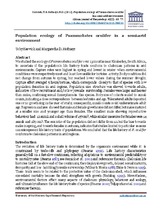Population ecology of Psammobates oculifer in a semi-arid environment
Abstract
We studied the ecology of Psammobates oculifer over 13 months near Kimberley, South Africa, to ascertain if the population’s life history traits conform to chelonian patterns in arid environments. Capture rates were highest in spring and lowest in winter when environmental conditions were respectively most and least favourable for tortoise activity. Body condition did not change from autumn to spring, but reached lower values during the summer drought. Capture effort averaged 5 hours/tortoise, which corresponds closely to that of species with low population densities in arid regions. Population size structure was skewed towards adults, indicative of low recruitment and/or low juvenile survivorship. Females were larger and heavier than males, confirming sexual dimorphism in this species. Body size of cohorts scaled to annuli counts, indicating a close correspondence between body size and age. Telemetered adults deposited one or no growth ring in the year of study; consequently, annuli counts could underestimate adult age. Regression analyses showed that male and female growth rates did not differ, but males matured at a smaller size and younger age than females. The smallest male showing reproductive behaviour had 12 annuli and a shell volume of 157 cm3, while similar measures for females were 14 annuli and 185 cm3. The sex ratio of the population did not differ from 1:1 but the bias towards males in spring, and towards females in autumn, indicates that studies limited to particular seasons can misrepresent life history traits of populations. We concluded that the life history of P. oculifer conforms to chelonian patterns in arid regions.

